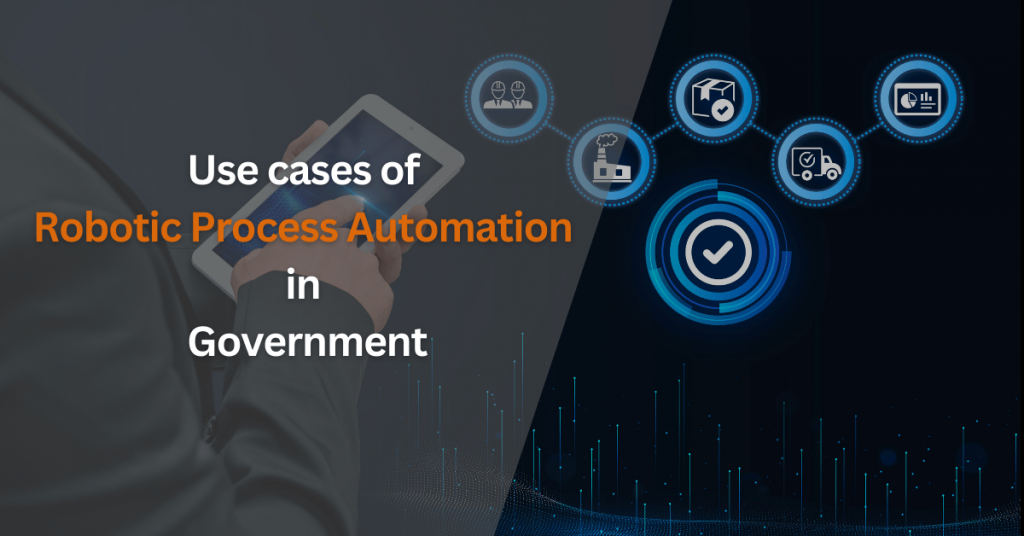Table of Contents
Introduction to RPA
Put simply, making robots operated by software (bots) carry out repetitive tasks that are usually done by humans is called robotic process automation. The primary role of RPA in government includes replicating human actions like data-entry, making reports, and cross-checking information, which makes everything faster overall.
When it comes to the public sector, RPA is a godsend since it has the ability to significantly bring down operational costs and improve the quality of service. Governments across the globe have been welcoming RPA into several processes to cut down on the work pressure of human staff, while multi-folding efficiency. RPA in public sector is also super useful when talking about relocation of resources for more strategy-based objectives.

That being said, let’s take a look at some of the key stats related to RPA:
Around 40% of tasks in the government sector can be easily automated.
RPA can help cut down the overall processing time by roughly 50%.
Introduction of RPA in the existing frameworks can boost accuracy by around 90%.
RPA for government can help achieve as much as a 30% cut in operational costs.
Key Challenges in Government & Public Sector
Governments, regardless of the region, have to deal with a wide range of operational challenges. From slow manual tasks, skyrocketing operational expenditure, and poor service, to outdated technology, the list doesn’t end. These challenges tend to affect the ability of the public sector to deliver high-quality services to its citizens.
Let’s dive into some of the most common challenges that RPA in government could solve:
Tedious Offline Processes
Most of the government offices still depend on physical stationery like papers and files to record everyday data. This opens up a large window for data loss, delays, errors, and more factors that come along with humans involved.
Uncontrollable Costs
Since non-automated tasks require a large workforce, organizations often face a significant upfront investment. This directly leads to disruption in a government’s budget and causes further complications to how an organisation plans to allocate it. To top it all, if the budget is for a project related to healthcare or education, the matter gets worse.
Sluggish Service
Since it’s next to impossible to set a streamlined workflow that a physical workforce can follow, tasks of several kinds take more time than usual to complete. It simply makes the citizens more agitated and frustrated during the times when they need proactive services.
Lack of Quality
One of the biggest issues with government organisations across the globe is the low-quality data. Such kind of data makes complex processes even more complicated since it sets the foundation wrong. Moreover, incomplete or faulty information may also become the cause of irregularities in scheduled audits.
Low Transparency
Manual processes often make performance tracking challenging, resulting in inaccurate data. This lack of clarity can lead to transparency issues and make it difficult for government officials to hold staff members accountable when needed.
Regulatory Issues
Government organisations need to manage a wide range of compliance policies and regulatory standards. Manually tracking each department demands a huge amount of time and effort and is often inefficient.
Stressed-out Staff:
Since the human staff is busy carrying out several types of monotonous tasks, they lose a great deal of time every day. Eventually, ending up exhausted, it becomes next to impossible to deliver on tasks that demand a strategic mindset. Employees also seem to move towards a stage of exhaustion or burnout because of physical stress.
Outdated Technology Infrastructure
Several government organisations using outdated frameworks find it difficult to make the existing technology pair well with the latest in the market. This gives rise to a tricky situation, where even when an agency wants to adopt new technology, it fails to do so, owing to compatibility issues.
How RPA in Government Helps Overcome Challenges
RPA for the public sector helps in resolving a wide range of challenges that are faced by governments that have to deal with monotonous and repetitive tasks. It aims at positioning robots operated via software in place of human staff. There is no end to the variety of benefits that RPA brings to the table, from improved information storage and processing, enhancing transparency, to better service – it covers it all. Let’s check out the list of benefits that RPA in government brings along:
Increased Precision
It’s super simple to automate tasks like data validation, entry, and analysis with the help of RPA. Government offices can enjoy faster and better process outcomes for day-to-day operations with the help of RPA integration.
Increased Savings
For tasks that are labor-intensive in nature, RPA helps in bringing down the overall number of humans required to pull it off. This in turn allows for a considerable amount of savings when it comes to the total cost of operations. This way, fewer employees are required and resources can be utilized in a much better manner.
Better Error-handling
Several errors that are usually found in tasks that are handled by humans can be eliminated with the help of RPA in government. Moreover, RPA also brings down the chances of errors that may cost a fortune by efficiently managing documents, applications and tax-related statements.
Better Service
There are several backend processes in the public sector that involve a lot of physical effort, which takes up a lot of time. In cases like licensing of permits and similar documents, RPA for public sector can boost the system by handling applications in a much faster way.
Boosts Data Processing
When it comes to processing huge chunks of data, RPA improves existing systems by updating information automatically. These software-operated bots assist by gathering data from several places and analysing it for complex decision making.
Increased Transparency and Auditing
Auditing is something that gets all departments sorting their data in a jiffy. What if all of this could be done without using a muscle? RPA does exactly that by maintaining a clean record of data which is collected by bots. So when an audit is carried out for various purposes, all the relevant insights into the system are available and open to criticism, increasing overall trust.
Better Compliance
A process that consistently follows rules set by relevant authorities is considered streamlined. RPA in government ensures that existing frameworks align with regulations and compliance standards, helping agencies follow guidelines consistently and accurately.
Shift in Focus
When RPA handles routine tasks, human staff gain more time to focus on higher-value work. This allows them to develop new engagement models, launch campaigns, create policies, and contribute to more strategic initiatives.
Assists Growth: RPA for the public sector is also a blessing to the government organizations that are planning to scale efficiently. With its trained bots, it can easily manage a large quantity of processes without the need for an upfront capital investment. This makes RPA a perfect choice for agencies that are looking to meet the ever-growing demand for services.
Key Use Cases of RPA in Government and Public Sector
From automating manual processes to filing taxes, there are many applications of RPA in government. Let’s dive into some of the most common RPA use cases in government sector:
Verification of Documents
RPA can pull out critical information from important documents and cross-check it with the existing data. For example, in the case of a permit application, it can go through all the documents that are necessary to qualify, properly filled, and stick to the regulations. This helps make the process faster and lowers the chances of human error.
Dynamic Data Sharing
More often than not, it becomes difficult for government organizations to mange the information that travels through different departments. RPA helps in developing a common platform for data sharing across multiple channels, which allows for faster information exchange. This is considered among the best RPA use cases in government domain.
Information Management
Governments across the globe need to process massive chunks of information, which often results in unforeseen misunderstandings or miscommunication. In such cases, RPA can figure out the data that’s incorrect or spot any type of duplicates to update the existing framework. This allows for regular maintenance of data related to finances, policies, and more.
Report Generation
One of the most popular applications of RPA in government sector is report generation and auditing. In the government sector, report generation and auditing are critical functions. Audits are often complex, and many inconsistencies arise from inaccurate or faulty databases. RPA helps streamline these processes by significantly reducing the time needed for accurate information gathering and processing.
Addressing Applications
Among the top challenges that the public sector faces is dealing with the huge volume of applications for licenses and welfare. RPA automates several aspects of the process, including qualification criteria, document cross-checking, and sending out confirmation to applicants. This reduces the overall waiting period for the citizens and eliminates any complexities involved.
Tax Management & Revenue Forecasting
One of the finest RPA use cases in government is automated tax gathering and revenue prediction. This includes sending out tax notices, going through massive chunks of user data and validating their invoices. Moreover, this also makes the entire process easier for taxpayers, since the efforts involved are bare minimum – thanks to the automation.
Future of RPA in Government and Public Sector
Organizations can’t ignore the benefits of RPA, considering how quickly and easily it simplifies their processes. RPA in government is gaining more and more acknowledgement as technology is evolving. With other equally impressive platforms like AI and ML growing along, we could say that RPA has barely scratched the surface.
Here’s a look at what we can expect from RPA in public sector in the years that follow:
- AI Compatibility: Government organizations will be able to catch fraudulent activities and improve several other processes with the combined tech-stack of RPA and AI.
- Widescale Implementation: The government agencies will reap the benefits of constantly growing adoption rates of RPA in traffic management, legal procedures, and welfare campaigns.
- Upgraded Communication Systems: RPA for government, by building smart frameworks for citizens that include platforms like virtual assistants, will help citizens save more time and effort.
- Growth Possibilities: Government organizations planning to scale their functions will be able to do so in a much optimized manner, with RPA handling all complex tasks involved via the cloud.
Conclusion
Robotic process automation services are changing the way governments in different corners of the world have been operating. Gone are the days when officials had to manually go through thousands of files every day, only to know they had missed an entry in one of them – causing a complete mismatch in the data.
Government agencies across various departments are welcoming RPA for all the right reasons. It optimizes existing systems, boosts service efficiency, and meets the demands of modern citizens.
In the years to come, RPA will go shoulder to shoulder with ML and AI, and further evolve the government sector. This will not only help in achieving faster outcomes but also make everything more transparent. RPA makes it easier for public sector to operate more seamlessly, forecast requirements better, and make the systems more responsible.








